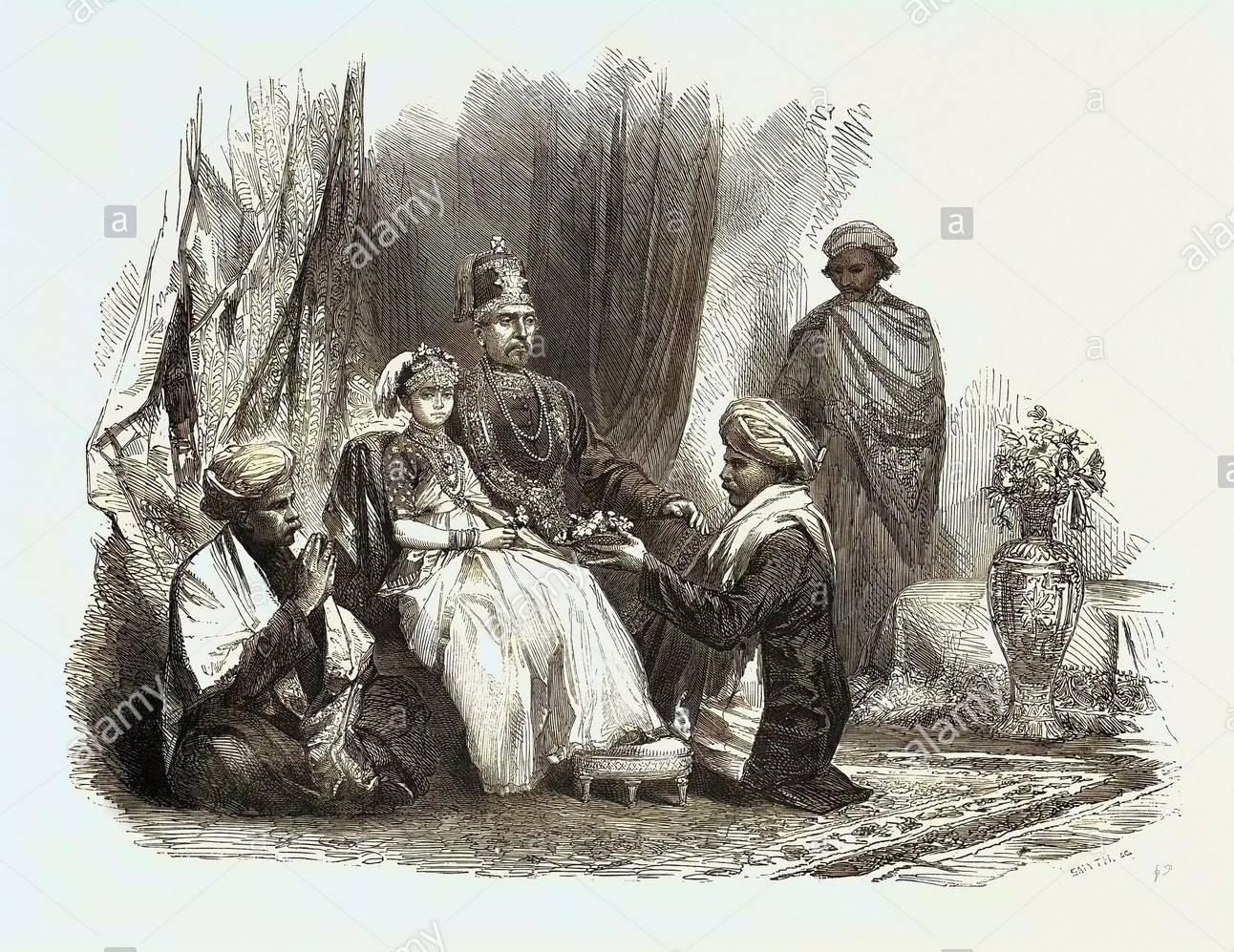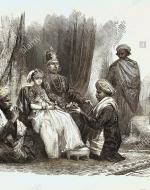Created by Mae Madrid on Fri, 10/23/2020 - 01:58
Description:
India was already under British crown control after 1858 but the relationship between Great Britain and India became even more significant when Queen Victoria was proclaimed the “Empress of India” on April 27, 1876. This title showcased Britain as a dominant world power and allowed the monarchy to be further linked to the Indian empire (Taylor 264). At first, Queen Victoria did not show much interest in the country, but later on she helped facilitate diplomatic matters. In 1852, Queen Victoria hosted the visit of Chikka Virarajendra and his 11-year old daughter, Princess Gouramma at the Buckingham Palace. They were the first Indian royals to ever set foot in England. Virarajendra was the ruler of Coorg in the south west of India until he was removed from his position after his kingdom was annexed. (Cooke 230). Virarajendra visited the queen to ask for help in retrieving his wealth which was stolen by the East India Company and to have Gouramma educated in Britain. Queen Victoria welcomed the king and his daughter with royal treatment and the queen immediately became fond of Gouramma, so the king left his daughter under her care and the queen decided to become her godmother. Gouramma was given the queen’s own name and she became officially known as Victoria Gouramma. She was also baptized at the Buckingham Palace by the Archbishop of Canterbury (Cooke 230). From then on, Princess Gouramma was declared an honorary princess and was placed under the care of royal guardians. At the same time, the queen herself took an active interest in the princess’ education and upbringing. Gouramma was often seen playing with the royal children and visiting different royal residences. (Login 150-151).
Eventually, Princess Gouramma grew up to be a beautiful, young lady and the queen wished for her to marry a wonderful man, so started to look for potential husbands. Queen Victoria wanted to set the princess up with Duleep Singh, the young Maharajah of Punjab. He had lost his kingdom after Punjab was annexed by the East Indian Company, which was similar to what happened to Chikka Virarajendra, Gouramma’s father. Duleep Singh had just recently converted to Christianity and he also received a formal Western education just like Gouramma did. At the same time, he maintained a close friendship with the royal family (Login 172). Queen Victoria thought they were compatible and that their union in marriage would also encourage the spread of Christianity in India. Unfortunately, Gouramma and Duleep Singh were not attracted to each other and instead maintained their friendship. Instead, Duleep encouraged a relationship between Gouramma and the handsome Colonel John Campbell who served in the army in India. Campbell was known to be a gambler himself and he looked at their marriage as a source of wealth. Duleep married another woman, Bamba Muller while Gouramma married Campbell in 1860. They had a daughter the following year of their marriage, named Edith. Their marriage did not last long because Princess Victoria Gouramma died due of tuberculosis on March 30th,1864 (Login 194).
As a member of the royal family, Princess Gouramma was often featured in paintings created by specific artists employed by Queen Victoria. The queen had expressed her displeasure towards English artists, in terms of their artwork and the prices they charged. The queen has grown up being painted by various artists, but many of them failed to satisfy certain requirements. (Barilo von Reisberg 1). Franz Xaver Winterhalter, a German painter and lithographer, was successfully employed by the royal family. He arrived in London in June 1842, and he immediately began working on a three-quarter length portrait of Queen Victoria and Prince Albert, which were considered successful. Winterhalter was able to capture the essence of the queen and prince in his portraits, so these paintings became the official representations of the queen and prince for years to come (Barilo von Reisburg 2). Queen Victoria invited Winterhalter to return to England in 1843 and he began his work on creating official full-length portraits of Queen Victoria and Prince Albert with oil on canvas. From then on, the queen has entrusted Winterhalter to paint many portraits for the royal family, including the 1852 painting he created of Princess Victoria Gouramma.
Works Cited:
Barilo von Reisberg, Eugene. “Garters and Petticoats: Franz Xaver Winterhalter’s 1843 Portraits of Queen Victoria and Prince Albert.” Emaj: Electronic Melbourne Art Journal, no. 5, Jan. 2010, pp. 1–
16. EBSCOhost, search.ebscohost.com/login.aspx?direct=true&db=aft&AN=505293875&site=ehost- live&scope=site.
Cooke, K. Clement. A Memoir of Her Royal Highness Princess Mary Adelaide, Duchess of Teck, Volume 1. New York City, Charles Scribner's sons, 1900.
Login, E. Dalhousie. Lady Login’s Recollections: Court Life and Camp Life 1820-1904. London, Smith, Elder & Co. 1916.
Royal Parks. Chikka Veerararenjda - the last King of Coorg, and his daughter, Princess Gowramma. https://www.royalparks.org.uk/parks/brompton-cemetery/explore-brompton- cemetery/princess-victoria-
gouramma. Accessed 20 Oct. 2020.
Taylor, Miles. “Queen Victoria and India, 1837-61.” Victorian Studies, vol. 46, no. 2, 2004, pp. 264–274. JSTOR, www.jstor.org/stable/3830294. Accessed 22 Oct. 2020.
Winterhalter, X. Franz, Portrait of Victoria of the United Kingdom. 1843, WikiArt. https://www.wikiart.org/en/franz-xaver-winterhalter/portrait-of-victoria-of-the-united-kingdom. Accessed 20 Oct. 2020



